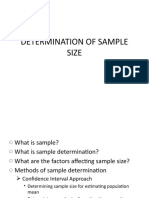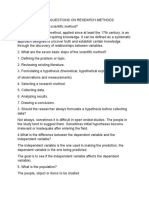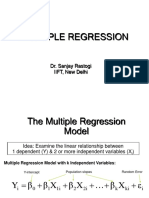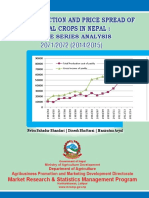0 ratings0% found this document useful (0 votes)
200 viewsSampling
Sampling is a technique used to select a subset of a population to make inferences about the whole population. It involves defining the population, identifying a sampling frame, selecting a sampling design, determining sample size, and drawing the sample. The main advantages of sampling are lower cost and faster data collection compared to a census. Probability sampling methods like simple random sampling give each unit an equal chance of selection, while non-probability methods do not. Common sampling designs include simple random sampling, stratified random sampling, systematic sampling, cluster sampling, and multi-stage sampling. Both sampling error and non-sampling error can occur and affect the accuracy of sample results.
Uploaded by
119936232141Copyright
© © All Rights Reserved
Available Formats
Download as PPTX, PDF, TXT or read online on Scribd
0 ratings0% found this document useful (0 votes)
200 viewsSampling
Sampling is a technique used to select a subset of a population to make inferences about the whole population. It involves defining the population, identifying a sampling frame, selecting a sampling design, determining sample size, and drawing the sample. The main advantages of sampling are lower cost and faster data collection compared to a census. Probability sampling methods like simple random sampling give each unit an equal chance of selection, while non-probability methods do not. Common sampling designs include simple random sampling, stratified random sampling, systematic sampling, cluster sampling, and multi-stage sampling. Both sampling error and non-sampling error can occur and affect the accuracy of sample results.
Uploaded by
119936232141Copyright
© © All Rights Reserved
Available Formats
Download as PPTX, PDF, TXT or read online on Scribd
You are on page 1/ 23
Sampling
All the items in any field of inquiry constitute
universe
A complete enumeration of all items in the
population is known as census inquiry .Census
method gives accurate results but in some
situations it is not possible to apply this
method
Selection of few units as a representatives of
population is known as sample
SAMPLING
Sampling is a technique which is concerned with the selection
of a subset of individuals from within a population to
estimate characteristics of the whole population.
Lower cost and faster data collection.
Advantages of the sampling
technique
Much cheaper.
Saves time.
Much reliable.
Very suitable for carrying out different surveys.
Scientific in nature.
SAMPLE DESIGN
A sample design is a definite plan for
Obtaining a sample from a given population. It
refers to the technique or the procedure the
researcher would adopt in selecting items for
the sample.
CHARACTERISTICS OF A GOOD
SAMPLE
Sample must be a truly representative of
population.
Sample must be such which results in a small
sampling error
Sampling must be viable in the context of
funds available for the result study
Sample should be such that the results of the
sample study can be applied
STEPS OF SAMPLE DESIGN
DEFINE THE POPULATION
IDENTIFY THE SAMPLING FRAME
SELECT A SAMPLING DESIGN OR PROCEDURE
DETERMINE THE SAMPLE SIZE
DRAW THE SAMPLE
Sampling and Non sampling errors
Sampling errors arises due to the fact that only a
part of population is used to judge the population
parameters . This error arises when a sample is
not representative of the population.
In census survey there is no sampling error
The measurement of sampling error is called
precision of the sampling plan
Non sampling error arise at the time of collection
and preparation of data
There can be errors at the time of coding,
tabulation and computation
POPULATION
. A population can be defined as including all
people or items with the characteristic one
wishes to understand
there is very rarely enough time or money to
gather information from everyone or everything
in a population
For example, a manufacturer needs to decide
whether a batch of material from production is of
high enough quality to be released to the
customer or not? Here the batch is population.
TYPES OF SAMPLING
NON PROBABILITY SAMPLING
PROBABILITY SAMPLING
NON PROBABILITY SAMPLING
Non probability sampling is any sampling
method where some elements of the
population have no chance of selection (these
are sometimes referred to as 'out of
coverage'/'undercovered'), or where the
probability of selection can't be accurately
determined.
selection of elements based on assumptions
Types of non probability sampling
convenience sampling
judgment sampling
quota sampling
Snow ball sampling
Convenience sampling
Sample units are only selected if they can be
accessed easily and conveniently.
television reporters often seek so-called
people-on-the-street interviews to find out
how people view an issue. In this example, the
sample is chosen randomly, without use of a
specific survey method.
Deliver accurate results when the population
is homogeneous.
Judgement sampling
When a sample is taken based on certain
judgements about the overall population
The underlying assumption is that the
investigator will select units that are
characteristic of the population.
The critical issue here is objectivity: how much
can judgment be relied upon to arrive at a
typical sample?
Quota sampling
Sampling is done until a specific number of
units (quotas) for various sub-populations
have been selected.
For example, if there are 100 men and 100
women in a population and a sample of 20 are
to be drawn to participate in a cola taste
challenge, you may want to divide the sample
evenly between10 men and 10 women.
Probability sampling or random
sampling
When every item of population has equal chance to be
selected as sample.
Probability sampling is also known as the random
sampling or chance sampling
Different sampling schemes under random sampling
are as under:-
1. simple random samping.
2. stratified random sampling
3. systematic sampling
4 multi stage sampling
5 cluster sampling
Simple random sampling
When each unit of the universe has an equal
chance of its selection its called simple
random sampling, ie no item is given
preference or each unit is considered equally
important. It may be with or without
replacement. If a unit selected once is
replaced backto the population before the
next draw it is called with replacement
sampling and vice-versa.
How to select a simple random
sample?
By lottery: - one procedure of selecting a unit from the
population by simple random sampling consists in
associating the units of the population with identical
chits bearing numbers from 1 to n such that each chit is
associated with the unit having the number as its index
and then selecting one chit after mixing thoroughly all
the chits.
By random numbers:- the tables of random numbers
have been developed for selection of the sample in a
desired manner. the random numbers are generated in
such a way that digits 0 to 9 appear independent of
each other and approx equal number of times in table.
Stratified random sampling
In this type of sampling the population under
consideration is divided into a number of sub
populations called strata and then samples are
selected independently from each stratum.
This technique is called stratification.
Systematic sampling
Systematic sampling consists only selecting the
first unit at random the rest being automatically
selected according to the pattern. If we have a
population of size N and a sample of size n is to
be drawn then k=N/n is called the sampling
interval,
here r is called random start, once this r is
selected the entire sample is determined. Eg if
N=28 and n=7, then k=28/7=4
In this as the systematic sample is spread more
evenly over the entire population
Cluster sampling
Generally identification and location of an
ultimate unit require considerable
time.hwever once a unit has been located the
time taken for surveying a few neighboring
unit is small. The technique known as cluster
sampling consists of grouping the population
units and then slecting some of these groups
called clusters.
Multi stage sampling
Sometimes sampling is done in stages in order
to reduce the cost of the survey or to
concentrate upon field work. The procedure of
first selecting a large sized sample, and then
selecting a smaller no of units to form a
sample is called sub sampling or two stage
sampling.the larger size units are called the
first stage units and smaller size as second
stage units.
Sequential Sampling
Sample size is not fixed in advance but is
determined according to mathematical
decision rule on the basis of information
yielded as the survey progresses.This type of
sampling is used in statistical quality control
Single sampling
Double sampling
Multiple sampling
You might also like
- Strengthen HMIS in Tanzania Operation Plan100% (1)Strengthen HMIS in Tanzania Operation Plan25 pages
- Mr. Jayesh Patidar: Jaympatidar@yahoo - inNo ratings yetMr. Jayesh Patidar: Jaympatidar@yahoo - in53 pages
- IKM - Sample Size Calculation in Epid Study PDFNo ratings yetIKM - Sample Size Calculation in Epid Study PDF7 pages
- Files-2-Presentations Malhotra ORGNL PPT 11No ratings yetFiles-2-Presentations Malhotra ORGNL PPT 1140 pages
- Sampling Design & Different Types of Sampling TechniquesNo ratings yetSampling Design & Different Types of Sampling Techniques41 pages
- Principle of Statistical Regularity: Actually Derived From100% (2)Principle of Statistical Regularity: Actually Derived From2 pages
- Demand Estimation of Dairy Products and The Study of Distribution Network of GCMMF (Amul) - ChennaiNo ratings yetDemand Estimation of Dairy Products and The Study of Distribution Network of GCMMF (Amul) - Chennai39 pages
- Multiple Regression: Dr. Sanjay Rastogi IIFT, New DelhiNo ratings yetMultiple Regression: Dr. Sanjay Rastogi IIFT, New Delhi37 pages
- Cost, Production and Price Spread of Cereal Crops in Nepal-A Time Series Analysis 2072No ratings yetCost, Production and Price Spread of Cereal Crops in Nepal-A Time Series Analysis 2072174 pages
- The Tamilnadu Dr. M.G.R. Medical University, Chennai - 32: Methodology Examination Paper I - Research MethodologyNo ratings yetThe Tamilnadu Dr. M.G.R. Medical University, Chennai - 32: Methodology Examination Paper I - Research Methodology10 pages
- Sample Size for Analytical Surveys, Using a Pretest-Posttest-Comparison-Group DesignFrom EverandSample Size for Analytical Surveys, Using a Pretest-Posttest-Comparison-Group DesignNo ratings yet
- This Content Downloaded From 223.238.212.182 On Tue, 08 Nov 2022 09:30:54 UTCNo ratings yetThis Content Downloaded From 223.238.212.182 On Tue, 08 Nov 2022 09:30:54 UTC16 pages
- United Nations Secretariat Department of Economic and Social Affairs Statistics DivisionNo ratings yetUnited Nations Secretariat Department of Economic and Social Affairs Statistics Division13 pages
- LAB 3 - Traffic Volume (Method 1) OEL 1No ratings yetLAB 3 - Traffic Volume (Method 1) OEL 15 pages
- CS Form No. 212 Attachment - Work Experience SheetNo ratings yetCS Form No. 212 Attachment - Work Experience Sheet2 pages
- Costa Rica Research Project - Sample of WorkNo ratings yetCosta Rica Research Project - Sample of Work27 pages
- Extra Questions for Class 9 Geography Chapter 6 Population – Study PathNo ratings yetExtra Questions for Class 9 Geography Chapter 6 Population – Study Path33 pages
- Village and Town Directory: Part Xii - ANo ratings yetVillage and Town Directory: Part Xii - A468 pages
- Sampling & Sampling Distribution The Need For Accurate & ReliableNo ratings yetSampling & Sampling Distribution The Need For Accurate & Reliable5 pages
- Sampling Design & Different Types of Sampling TechniquesSampling Design & Different Types of Sampling Techniques
- Principle of Statistical Regularity: Actually Derived FromPrinciple of Statistical Regularity: Actually Derived From
- Demand Estimation of Dairy Products and The Study of Distribution Network of GCMMF (Amul) - ChennaiDemand Estimation of Dairy Products and The Study of Distribution Network of GCMMF (Amul) - Chennai
- Multiple Regression: Dr. Sanjay Rastogi IIFT, New DelhiMultiple Regression: Dr. Sanjay Rastogi IIFT, New Delhi
- Cost, Production and Price Spread of Cereal Crops in Nepal-A Time Series Analysis 2072Cost, Production and Price Spread of Cereal Crops in Nepal-A Time Series Analysis 2072
- The Tamilnadu Dr. M.G.R. Medical University, Chennai - 32: Methodology Examination Paper I - Research MethodologyThe Tamilnadu Dr. M.G.R. Medical University, Chennai - 32: Methodology Examination Paper I - Research Methodology
- Sample Size for Analytical Surveys, Using a Pretest-Posttest-Comparison-Group DesignFrom EverandSample Size for Analytical Surveys, Using a Pretest-Posttest-Comparison-Group Design
- This Content Downloaded From 223.238.212.182 On Tue, 08 Nov 2022 09:30:54 UTCThis Content Downloaded From 223.238.212.182 On Tue, 08 Nov 2022 09:30:54 UTC
- United Nations Secretariat Department of Economic and Social Affairs Statistics DivisionUnited Nations Secretariat Department of Economic and Social Affairs Statistics Division
- CS Form No. 212 Attachment - Work Experience SheetCS Form No. 212 Attachment - Work Experience Sheet
- Extra Questions for Class 9 Geography Chapter 6 Population – Study PathExtra Questions for Class 9 Geography Chapter 6 Population – Study Path
- Sampling & Sampling Distribution The Need For Accurate & ReliableSampling & Sampling Distribution The Need For Accurate & Reliable





























































































